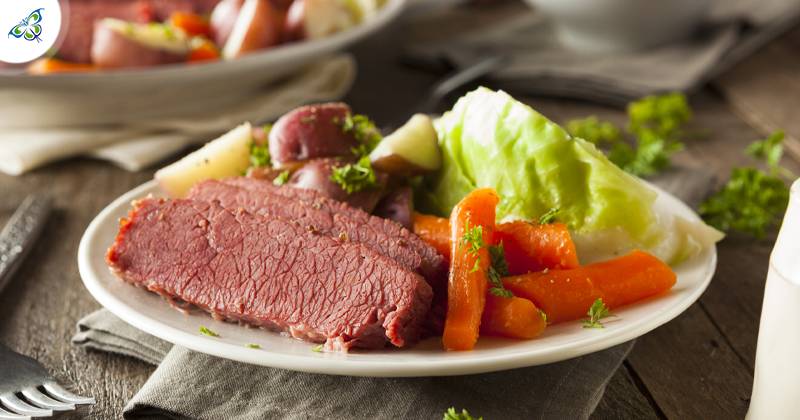Why corned beef for the Patrick’s Day celebration?

Back in the Middle Ages in Ireland, buying and eating beef was a luxury. Although the land has been famous for exporting salted meats for ages, yet, beef was always associated with some opulence. The pork was instead considered to be a cheaper option and whenever it came to celebrating holidays and religious occasions, many turned to salted pork (you can think of your favorite bacon)!
As America has been home to billions of immigrants since time immemorial, the Irishmen too, one day, arrived upon this land, they discovered that beef was not that costlier than pork. Rather, the converse was mostly true! This coronated beef to be the food for their occasions and celebrations. Corned beef happened to be that variety of beef that could be afforded by all.
So, what is corned beef?
Does corned beef contain corns at all? No, that’s indeed the irony – there’s no corn in corned beef. It refers to the curing of beef using salt. Here, the salt that's used is larger grains of rock salt. That’s how the nomenclature came into being – salt ‘corns’ being used to process beef briskets!
Here comes another point: why beef brisket? Beef brisket is the meat taken from the breast portion of the beef. Not that brisket is a tender section but it can be ideally cooked (at internal heat of 195 F to 200 F), smoked, and slowly roasted to render it the soft, mouth-watering attribute. Slow cooking ultimately breaks down the collagen and the muscle connective tissues to achieve softness!
The Irish-American dish…
As salt is a natural preservative, it was used as the medium of ‘corning’ beef so that the meat does not turn stale without refrigeration. As common Irishmen could not afford fresh beef (it being a luxury) the salted cut was the one that got popularized. When these people stepped into the American lands, beef was no longer so savory as it was back home! Instead, the kosher corned beef, at that time, turned out to be cheaper than even the salted pork!
The immigrants began preparing their cabbage with corned beef; St. Patrick’s Day, consequently, turned out to be an Irish-American event and not a purely Irish one!
Health impacts of your corned beef
The delectable corned beef that you are acquainted with has that pinkish hue, doesn’t it? So, what gives it that pinkish tint? The curing salt that is used to process the beef brisket is commercially known as Prague powder – a combination of sodium nitrite and table salt (sodium chloride). Prague powder is used in recipes that need short curing intervals before being cooked, like – hot dogs, sausages, etc.
While some argue that nitrites are harmful to health (causing hardening and narrowing of blood vessels leading to heart disease), others opine that vegetables like celery, spinach, and lettuce have ten times more nitrites than the ones present in meat cures!
The ‘nitrite-free’ variants
Some brands advertise themselves to be nitrite-free. These are the ones that use celery juice for the ‘pickling’ process. However, even celery juice contains sodium nitrate as a naturally occurring component. So, precisely, whichever form of cured meat you consume, you are surely intaking some amount of sodium nitrite!
To call the ‘corned beef with cabbage and potatoes’ an Irish-American delicacy would not be accurate enough. The Irish people happened to be settling near the Jewish immigrants and this combination was a choice of this mixed population.

Validate your login
Sign In
Create New Account